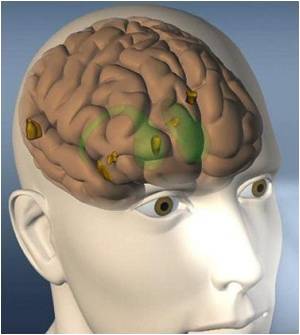
With the help of electroencephalography or EEG - electrodes placed on the scalp - study authors used new techniques to suppress the electrical signal associated with the DBS electrode. That enabled the first clear, non-invasive EEG measurements of the underlying brain response during clinically effective, high-frequency brain stimulation in humans.
The results show that nerves in the cerebral cortex, the outer layer of the brain, fire with rapid and precise timing in response to individual stimulus pulses. This suggests that DBS may synchronize the firing of nerve cells and break the abnormal rhythms associated with involuntary movements in Parkinson''s disease and essential tremor.
The newly identified rhythm was captured during effective DBS treatment, so it could represent a new physiological measure of the stimulation dose, say the authors. If validated, such a yardstick could help to guide the fine-tuning of DBS stimulator settings in patients for more lasting relief, fewer side effects and less-frequent battery-replacement surgeries.
"Though it''s clear that more work is needed to better understand these initial observations, we''re very excited by our findings because they may provide a biological marker for improvement in the symptoms of these patients," says Harrison Walker, M.D., assistant professor in the UAB Department of Neurology''s Division of Movement Disorders and lead author of the study.
In current clinical practice, stimulator settings are adjusted by trial and error, requiring careful observation of changes in symptoms over multiple clinic visits. But such immediate, visual feedback may not be available as DBS is applied to neurological or psychiatric conditions such as epilepsy, severe depression or obsessive compulsive disorder. In these diseases, an effective dose measurement could be especially useful in optimizing DBS therapy.
Advertisement
In both studies, EEG data revealed that nerve cells in the cerebral cortex discharged about one one-thousandth of a second, or one millisecond, after each stimulus pulse was delivered into the brain.
The authors argue that this rapid response on the brain''s surface most likely represented "backfiring" along extensions of cortical nerve cells called axons that connect them to deeper regions within the brain where the DBS electrodes were placed. Interestingly, this rapid response on the brain surface was present in both studies, regardless of the stimulation target or the disease state of the patient.
Advertisement
The new technique also enabled the researchers to show that the size of the brain response at one millisecond after a DBS pulse is dependent on the intensity or voltage of the stimulus pulse, and that larger brain responses were closely associated with improvement in tremor.
Along with Walker, study authors within the UAB Department of Neurology included He Huang, Christopher Gonzalez, James Bryant and Jeffrey Killen, along with Robert Knowlton, M.D. (now at the University of Texas at Houston Medical Center), Erwin Montgomery Jr., M.D., and Ray Watts, M.D., dean of the UAB School of Medicine. Additional contributions were made by Gary R. Cutter, Ph.D., in the UAB Department of Biostatistics in the School of Public Health, and Barton Guthrie, M.D., in the Division of Neurosurgery. The study was funded by the National Institute of Neurological Disorders and Stroke, part of the U.S. National Institutes of Health.
"While early, this work has tremendous implications for the understanding of brain mechanisms responsible for a number of neurological and psychiatric diseases," says Guthrie. "Further studies are planned to confirm these measures and mechanisms and we believe this insight will soon make valuable contributions to the next generation of DBS treatments."
Source-Newswise













